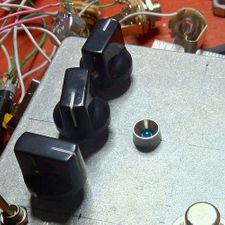Machaut at a banquet (Bibliothèque National, Paris, public domain, Wikimedia Commons)
Sampling, medieval France, love songs, John Cage
In the second of my SoundMakers Composer-in-Residence posts, I want to describe the piece I wrote (to be premiered spring 2015) and why I wrote what I did. Titled Longuement me sui tenus and scored for four vocal soloists (SATB) + electronics, the piece is based on a text by 14th-century French composer and poet Guillaume de Machaut. I didn’t set out to write a piece on a Machaut text, but as I did more research on themes connected to SoundMakers, Machaut kept coming up.
Longuement me sui tenus is the first line of Machaut’s Lay de Bonne Esperance, an epic 20-minute love song, to be performed a capella by a single singer. Musically, it doesn’t fit modern ideas of what a love song is, especially considering that it addresses unrequited love: it’s monotonous, strangely chipper, ramblingly bouncy, goes on forever, and doesn’t have much variety in terms of phrasing. Frankly, it’s kind of boring and I’ve never listened through an entire recording of the piece in one sitting. Yet still, something about the poetry stuck in my head. Somehow it felt like it was the right fit for my piece, even though I didn’t like the original very much.
I finally decided, what the hell, I’ll just go with it and see where it takes me. After all, Soundmakers is about reinvention and recontextualization. With the Machaut, I had a theme that is extremely common in modern musical practice (i.e. the love song), but I was looking at it through a lens that was completely alien, that didn’t make sense to me. In a way, it was so wrong it was right: it would force me to completely reimagine the idea of love song.
Excited, I promptly started hacking the text to bits, recombining phrases and partial sentences to come up with a version of the words that rang true to me. I scoured the Internet for Old French dictionaries and grammatical texts, spending many long hours pondering the implications of the simple past versus the subjunctive imperfect. I didn’t assemble the entire text right off the bat, but I got a couple of good fragments in place, then I put them to music to see what would happen.
To sample or not to sample…
To backpedal a bit, when I first started mulling this Soundmakers piece, I assumed I would be recontextualizing musical fragments, not a text. I made a cup of coffee, patiently downloaded all the samples from the Soundmakers site, and catalogued them according to the musical materials used and whatever sonic aspects grabbed my attention.
Sadly, that didn’t give me the “ah ha” moment I was hoping for. In fact, it raised new problems. I had four a cappella singers to work with, yet most of the audio samples were instrumental and wouldn’t work well when translated into vocal music. The few vocal samples I did find had strong identities of their own, and I wasn’t sure I could reinterpret them with the range of nuance I wanted.
I asked myself: Do I want this piece to be about sampling, with the singers working against preexisting recordings? Do I want to recompose some of the musical materials, quoting and transforming them acoustically with the voices? I’ve used both Love in the Time of Connectivity, and both work, but context is the key: the samples or quotations should connect fundamentally to the theme of the piece. Would I be able to do that here?
Meaning is important to me. Sure, you can use samples to create random, cool sounds, but when you do that it’s better if the original context is pretty much obliterated in the process. Otherwise it just sounds like you’re trying to freeload off of James Brown or Joe Tex or whoever you’re sampling. When I use samples or quotations, I want them to reflect on who I am, what I want to say—not what the original artist wanted to communicate.
The more I thought about it, the more samples and quotations seemed like a bad fit for this project. Sure, I could have made it work, but it wouldn’t have stood on its own. I wanted this piece to be first and foremost an engaging musical experience, not just an exercise in reappropriation. Maybe if I had had more choral samples, I might have gone a different direction. But since I didn’t, I decided to just write the music from scratch, then recontextualize elsewhere. (Well actually, if I’m being totally honest, I did give quotation a go at first, but I gave up after a couple of bars: the first harmony in the piece is derived from Paul Frehner’s Berliner Konzert, but that’s as far as it got.)
Reinventing the vocal chords
I’ve already talked about the Machaut text and why it appealed to me: a love song that felt so improbable that it was strangely appealing. I also wanted to reinvent the four singers at my disposal. I love writing for voice and I’ve done quite a lot of it, but four unaccompanied singers of different vocal types is a bit of an odd ensemble. I did request this combination, so it’s not like I didn’t know what I was getting into. But it’s a bit like having four individual socks of four different colours: you’ve got to find something unorthodox to do with them.
Consequently, I decided to reinvent the voices using electronics. There are a few major approaches to using electronics live in performance, and this piece falls into what you might call signal processing: taking a sound and changing it in some way. However, I didn’t want the piece to be about the act of processing the signal, I wanted it to be about the love song theme. I had to find a way to process the vocal sounds that would enhance the underlying musical and textual ideas, pulling attention away from the technological aspects of the piece.
Therefore, instead of drawing on electronic music as an inspiration, I looked to John Cage’s prepared piano studies. For those who are unfamiliar, in the late 1930s composer John Cage started sticking bits of felt, metal, rubber, and other objects into his piano strategically. This radically transformed its sound and made the playing of regular piano music more or less impossible. Inspired by the new sounds, he composed pieces that relied on them, turning the piano into a new kind of instrument.
Likewise, I wanted to compose for “prepared voices,” to write a piece that was rooted in the processed sounds I was generating and wouldn’t make sense for acoustic singers. I played around with a few types of sound processing in SuperCollider, my digital audio software of choice, and eventually settled on a patch that overlaps two delay lines of random lengths and intervals on each singer’s voice (to be detailed in a later post). I played with different delay settings to ensure I was still able to understand the text, then I started putting together test phrases, using synthesized sounds triggered in SuperCollider by my notation software, Sibelius. One of these tests is embedded below.
I wanted to see if the delay effect was both interesting and different enough from the acoustic voice that it would change my writing. Once I was happy with the effect, I also sung a few of the lines into a microphone to make sure it would work when the sound source was a voice. After a few more tests and lots of tweaking, I came up with a patch that struck the right balance: constantly varying, keeps the text intelligible, not artificial sounding, flexible enough to handle variations or performer error, and sufficiently transformative that regular vocal writing wouldn’t be an option. Satisfied that I had properly reinvented my materials, I set about composing the piece.
This article originally appeared on the SoundMakers composer-in-residence blog.




